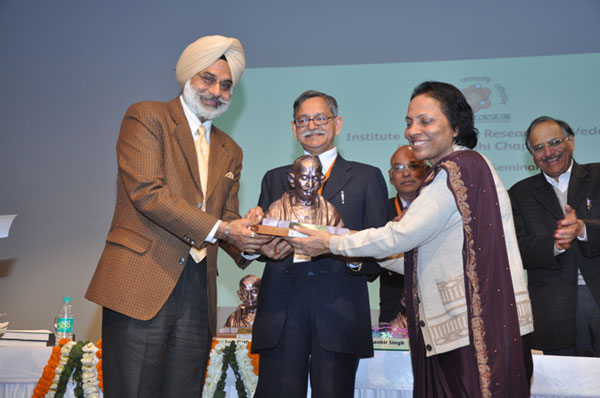Determining Cultural Continuity since Vedic and Epic Eras
International Seminar
on
“Determining Cultural Continuity since Vedic and Epic Eras: through Sequential Dating of Astronomical References and other Corroborating Scientific Evidences”
(23-24 February 2014)
The Seminar was organized by the I-SERVE Delhi Chapter at the auditorium of the Civil Services Officers Institute, Chanakyapuri, New Delhi. Hon'ble Dr Karan Singh, the then Member of Rajya Sabha and Chairman of ICCR delivered the Inaugural Address on 23rd February. Dr Kapil Kapoor delivered a very high-value address as the distinguished Guest of Honor. Smt. Saroj Bala, Director, I-SERVE Delhi Chapter, while welcoming the Chief Guest, Guest of Honor and all the participants, gave a brief description of the objectives and activities of I-SERVE and explained the theme of the seminar. Smt Sangeeta Gupta anchored the proceedings.
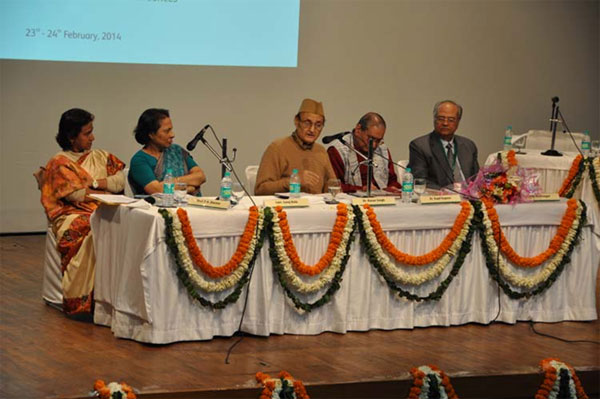
Important Note: This Seminar was an attempt at finding scientific and credible answers to the following questions-
- Do the astronomical references in Rigveda refer to the period 7000 BC to 5000 BC?
- Was Lord Ram born in 5114 BC and what is the truth behind Ramsetu?
- What could be the true dates of the Mahabharata war; how could these be determined?
- Are the astronomical dates corroborated by other scientific proofs?
- Has there been a cultural continuity in India for more than 9000 years?
Smt. Saroj Bala, the Chief Research Coordinator, briefed the participants about the research objectives of the Institute of Scientific Research on Vedas and about the achievements so far. She informed the participants that -
I-SERVE was established in 2004 under the chairmanship of Prof. K. V. Krishna Murthy, with Shri R. Venkataraman, former President of India, as its Patron-in-chief. She further informed that the I-SERVE Delhi Chapter has been working on a research project titled, Scientific Dating of Ancient Events from Rigveda to Aryabhatiyam: through astronomical dating of planetary references by making use of planetarium software and corroboration with archaeological, anthropological, palaeobotanical, geological, ecological, oceanographic and remote sensing evidences.

She threw some light on the immense success of the previous seminar titled: "Scientific Dating of Ancient Events before 2000 BC" held in July 2011 (inaugurated by H.E. Dr A.P.J. Abdul Kalam) and its outcome in the form of the book 'Historicity of Vedic and Ramayan Eras: Scientific Evidences from the Depths of Oceans to the Heights of Skies'. She informed that after a very encouraging response to this first publication, I-SERVE continued with multi-disciplinary scientific research, outcomes of which have revealed that indigenous civilization has been developing in India for more than 9000 years.
Pointing to a lot of inconsistencies in the modern writings on India’s heritage, she said that serious injustice has been done to our understanding of the antiquity and richness of India’s cultural heritage by scholars having a colonial and leftist mindset. She gave the example of books that place the time of Mahabharata earlier than Ramayana. In order to dispel this belief, she drew attention to ‘An Index of Names in Mahabharata, by S. Sorensen, 1904’, which lists more than 600 references to Ramayana, spread over thirteen Parvas of Mahabharata, but Ramayan is totally unaware of Mahabharat.

She added that I-SERVE is striving hard to bring the truth of India’s rich heritage to light. Encouraged by the response from scientists and scholars, the I-SERVE Delhi Chapter has organized the present seminar to showcase the results of its recent research covering Scientific dating of astronomical references from Rigveda to Mahabharata and determining cultural continuity since those times along with corroborating evidence from other scientific disciplines. Besides astronomical dating, the presentations include human Genome studies of populations, Geological and Seismo-tectonic evidence, Archaeological findings on human settlements, Radio-carbon dating, Paleo-botanical studies, Remote-sensing studies of paleo-channels of Vedic River Saraswati, continuity in arts and crafts through ages and Science and Technology since Vedic time.
In the opening session on 23rd Feb. 2014, Smt. Saroj Bala provided an overview of the topics which were to be covered in this Seminar. The topics along with the names of the Speakers are listed as under -
| Sl. no. | Topic | Names of Speakers |
|---|---|---|
| 1 | An Overview of the Seminar | Smt. Saroj Bala, IRS (Retd. Member, CBDT), Director, I-SERVE Delhi Chapter |
| 2 | Inaugural Address to the Seminar | Hon'ble Dr Karan Singh, Member of Rajya Sabha and Chairman of ICCR |
| 3 | Special Address providing valuable information on the subject | Dr Kapil Kapoor, Retd. Pro-VC, JNU, an eminent scholar & respected author, as the distinguished Guest of Honor. |
| 4 | Astronomical Dating from Rigveda to Mahabharat - using planetarium software | Shri Ashok Bhatnagar (Former Addl. Director General, IMD), Director (Technical), I-SERVE Delhi Chapter |
| 5 | Astronomical Dating of Mahabharata Era- making use of the planetarium software | Prof. B.N. Narahari Achar, Department of Physics, University of Memphis, USA |
| 6 | Effective Endeavours for Unification of India since Vedic times | Dr K.S. Valdiya, Emeritus Professor of Geodynamics, Jawaharlal Nehru Centre for Advanced Scientific Research, Bengaluru |
| 7 | Plants Mentioned in Vedas, Epics and Puranas: Scientific and Radiometric Data | Dr C.M. Nautiyal, Scientist In-charge, C-14 Dating Laboratory, Birbal Sahni Institute of Palaeobotany, Lucknow |
| 8 | Signatures of Human Settlements before 1500 BC in the Indian Sub-continent: Inputs from Archaeology | Shri Kulbhushan Mishra, Research Associate, Indian Archaeological Society and Dr Vimal Tiwari, Assistant Archaeologist, ASI, Lucknow |
| 9 | Genealogical charts of Ancient Rulers since the Vedic and Epic eras | Shri Baldevanand Sagar, Sanskrit Scholar and news editor on AIR |
| 10 | Concordance of Vedic and Epic knowledge with peopling of modern South Asia | Dr Gyaneshwar Chaubey, Senior Scientist in Estonian Biocentre, University of Tartu |
| 11 | Vedic Saraswati River Network in the Quaternary Period from Man Sarovar to Dwaraka: Perceived through Satellite Remote Sensing | Dr J.R. Sharma and DR B. K. Bhadra, Regional Remote Sensing Centre, ISRO, Department of Space, CAZRI Campus, Jodhpur |
| 12 | Ancient Janas to Janapadas in the context of Epics and Puranas | Dr. B.R. Mani, Addl. Director General, Archaeological Survey of India, New Delhi |
| 13 | Science since Vedic times | Prof. Krishna Bihari Pandeya, Vice Chancellor (retd.), Mahatma Gandhi Chitrakut Gram Udaya Vishwavidyalaya. |
| 14 | Art and Craft since most ancient (Vedic) Times and continuity through the ages* | Prof. Vasant Shinde, V.C. & Director (IC), The Deccan College Post Graduate and Research Institute, Pune |
| 15 | Mahabharata describes Harappan iconography as Vedic. | Dr Navaratna S. Rajaram: a mathematician, historian, linguist and eminent author -from Boston, USA & Bangalore, India. |
| 16 | Summation of the Seminar Proceedings | Saroj Bala, Director of I-SERVE Delhi Chapter |
Venue: Civil Services Officers' Institute (CSOI) Auditorium, Chanakyapuri. Organized by: I-SERVE Delhi Chapter, Institute of Scientific Research on Vedas
For more information and videos on the subject visit -
https://www.youtube.com/c/RigvedatoRobotics/videos
Seminar 2014: Determining Cultural Continuity since Vedic & Epic Eras – An Overview by Smt. Saroj Bala
- Smt Saroj Bala informed that sequential astronomical dates of references in Rigveda, Ramayan and Mahabharat have been determined using Planetarium software; presentations will be made by Shri Ashok Bhatnagar and Prof. B.N. Narahari Achar.
- Dr J.R. Sharma and Dr B.K. Bhadra, two eminent scientists from ISRO would present the satellite images of paleo-channels of ancient Sarasvati River proving that 9000 to 6000 years back (during Rigveda and Ramayana Era), Sarasvati was flowing with full majesty and slowly started drying up at different places due to several factors.
- Some of the most eminent archaeologists like Shri Dr B.R. Mani, Dr Vasant Shinde, and Shri Kulbhushan Mishra, would make presentations on samples and artefacts having C14 dates from 7000 BCE to 1200 BCE, which include houses, plants, metallurgy, art, craft, jewellery, utensils, terracotta etc. excavated from several sites in Indus, Sarasvati and Ganga belts. (All these presentations are also available on sarojbala.blogspot.com).

- A presentation on Genealogical charts of Ancient Rulers since the Vedic and Epic eras by Shri Baldevanand Sagar, followed by Concordance of Vedic and Epic knowledge with peopling of modern South Asia based the Gene inflow and outflow studies by Dr Gyaneshwar Chaubey of Estonian Biocentre, Tartu.
- DR K S Valdiya would throw light on Effective Endeavours for the Unification of India, i.e., developing One Bharat since Vedic times. Dr Nautiyal was expected to deal with plants since the Vedic era, especially those of Mahabharat times.
- Dr Navaratna Rajaram explained through examples that Mahabharata describes Harappan iconography as Vedic. Winning the applause of the public, Dr K B Pandya threw light on the subject ‘Science since Vedic times’.
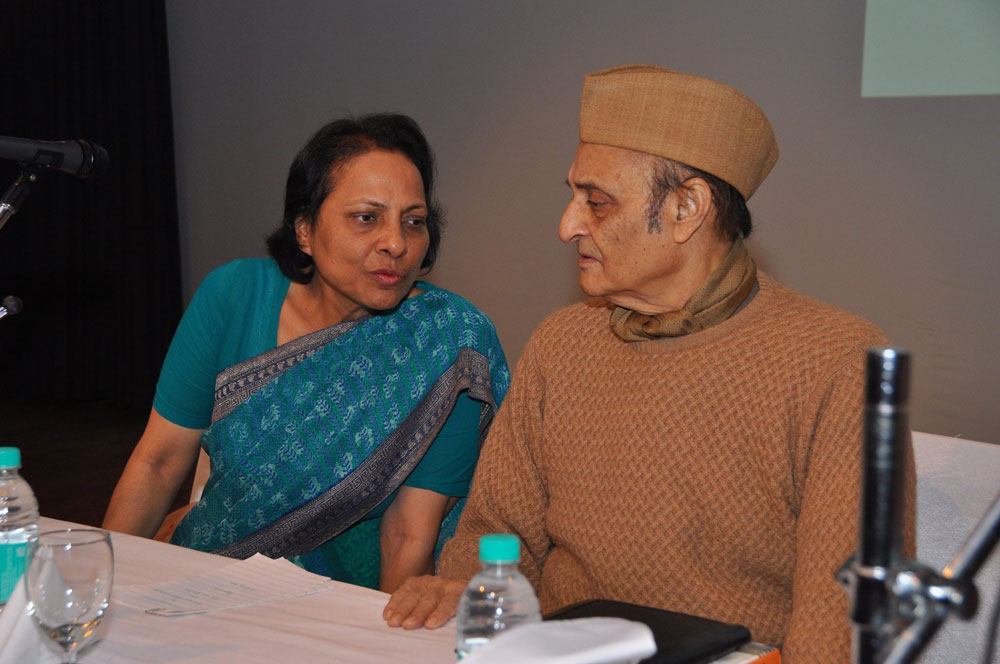
Finally, Smt. Saroj Bala expressed the opinion that the subject 'History' needs to be placed under the Faculty of Sciences as a Multi-Disciplinary Science Subject’ so that the true and precise ancient history of the Indian Subcontinent is written afresh. After all the future of mankind depends on the true appreciation of the past!
Inaugural Address by Dr Karan Singh on 23rd February 2014
While delivering the inaugural address, Dr Karan Singh, the then Chairman of ICCR, appreciated the innovative and most reliable method of determining the dates of references in Vedas and Epics along determination of the exact dates of events narrated therein. Being a profound scholar of Hindu Dharma and ancient Indian culture, he gave some valuable advice as well. He said -
- Vedic civilization is probably the oldest civilization in the world and Vedas are not only superb poetic compositions but also contain the divine truth perceived through the elevated consciousness of the great seers.
- The Institute of Scientific Research on Vedas has devised a very original and very fascinating method for determining the dates of events mentioned in Vedas and Epics, i.e., extract the planetary references and then determine the exact astronomical dates of events making use of Planetarium software.
For more information and videos on the subject visit -
https://www.youtube.com/c/RigvedatoRobotics/videos
- Astronomical dates of sequential planetary references in these texts, determined using Planetarium software, would probably be the most credible dates of events narrated therein. And then correlating these with carbon dates of archaeological samples and artefacts, comparing ancient genealogies with modern genetic studies would indeed be very interesting.
- Vedic and post-Vedic literature contains the most profound philosophy about all aspects of human life. However, exaggerated claims about the achievements of ancient India have done a lot of harm to the credibility of our ancient texts. He appreciated that the new methodology evolved by the Institute of Scientific Research on Vedas for determining the dates of Vedas and Epics is convincing as well as fascinating.
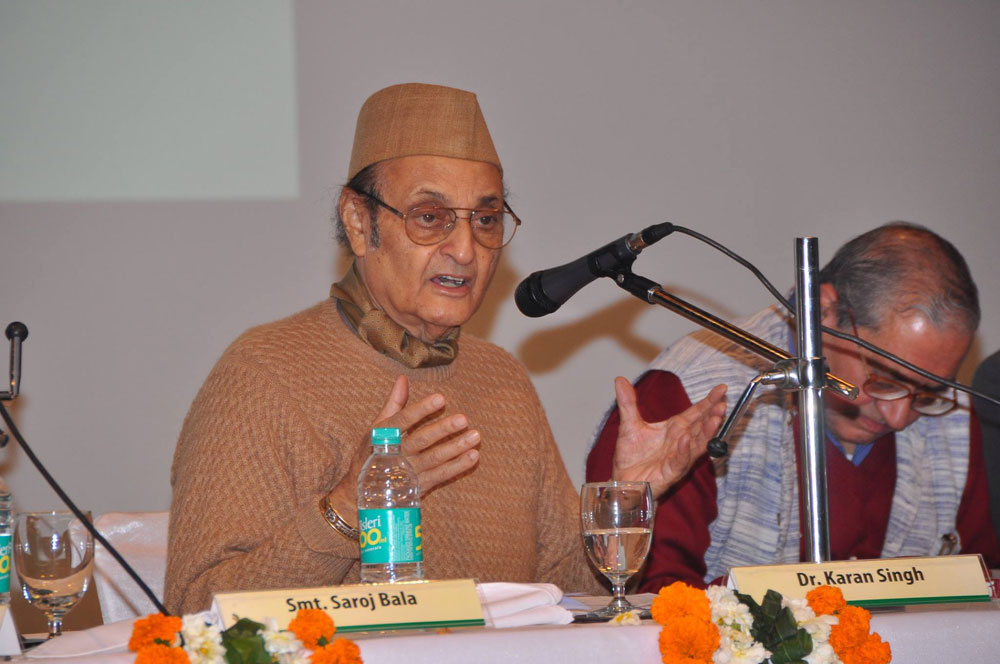
- He added that people tend to take the achievements of the past to the extreme - either dismissing the achievements completely or going hyperbolic. Neither is correct. He lauded the efforts of I-SERVE and added that the critical approach will help in enhancing our knowledge for looking at things objectively.
- Indian cultural heritage accepts multiple paths to the divine. Gita is a dialogue between Krishna and Arjun when Arjun constantly keeps on asking questions and Shri Krishna keeps answering most willingly and without any irritation.

Address by Dr Kapil Kapoor
Dr Kapil Kapoor, former Pro- Vice-Chancellor of JNU, New Delhi, in a special address, showed the evolutionary way of thought process with the development of language, pointed to the continuity of knowledge in India for thousands of years and related it to the great wisdom found in the most common Indians. He explained through interesting examples how the traditional Indian wisdom is known to a Rickshaw Pullar, a Labourer and a common man in the street. It is because, for thousands of years, this has gone to his genes.
He also stated that Sanskrit is actually the mother language for most of the languages of Asia and Europe. He said that actually, people from Bharat Varsha had been migrating to Europe for thousands of years. He explained through examples from vocabulary, based on phonetics. He gave several examples including the names of months – September means ‘saptam ambar’, October means ‘ashtam ambar’, November means ‘navam ambar’, and December means ‘dasham ambar’. There are thousands of examples of such types.
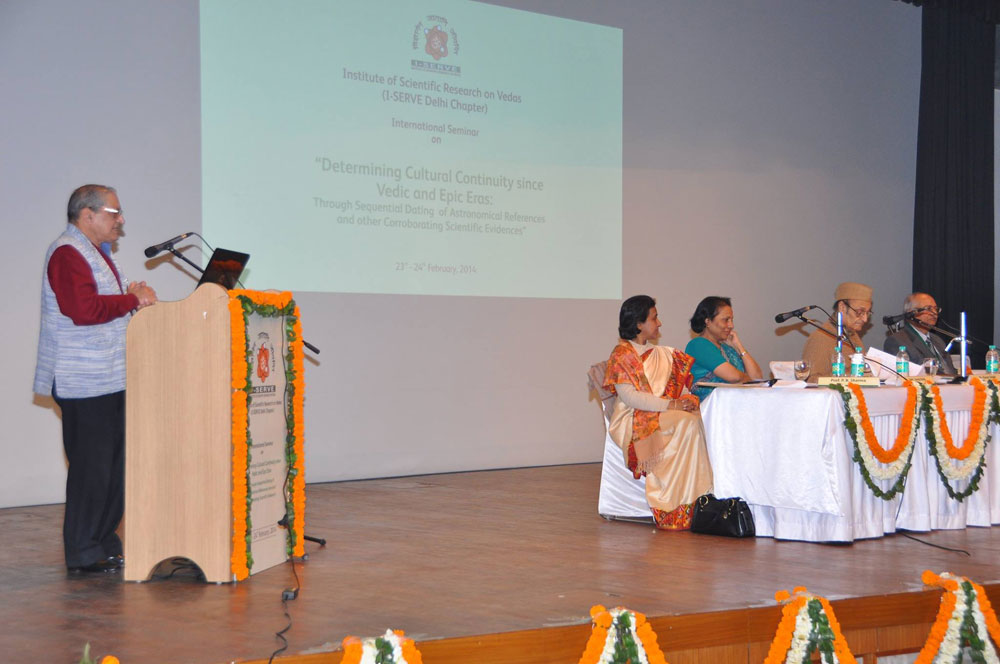
Presentation by Shri Ashok Bhatnagar
There were two presentations on astronomical determination of dates of references and events narrated in Vedas and Epics. Shri Ashok Bhatnagar, Technical Director, I-SERVE (former Director, Positional Astronomy Centre and Additional DG, India Meteorological Department) made a presentation on ‘Astronomical dating from Rigveda to Mahabharata’. For Mahabharat dates Shri Bhatnagar narrowed down the search to the period 2150 BCE to 1280 BCE by tying up Kartik month to autumn season, which is described in detail in the epic. Next, a search was made for the eclipses as described in Mahabharata around this period using the latest Canons of eclipses published by NASA; and 75 pairs of eclipses of Sun and Moon were shortlisted. Finally, the details of Winter Solstice Day, as given in the text, were used to determine the precession in the longitude of Magha (α Leonis). The sky simulation with these details provided the unique date for the Winter Solstice in the year -1792 (1793 BCE), from where the rest of the sequence of events in Mahabharata fell in place. Accordingly, Shri Bhatnagar determined 14 October, -1792 (1793 BCE, Gregorian) as the date of the beginning of the Mahabharata war and concluded that the sky simulations of astronomical and seasonal events show that these must have been observed sequentially and recorded in Mahabharata. Shri Bhatnagar also explained that the astronomical and calendric framework that evolved from the Vedic times through Mahabharata has survived until the present and forms the backbone of Indian cultural life to this day.

Shri Ashok Bhatnagar behind Dr Karan Singh
Presentation by Prof. B.N. Narahari Achar
Prof. B.N. Narahari Achar of the University of Memphis, USA made the next presentation on ‘Astronomical Dating of Mahabharata Era- making use of the Planetarium software’. He made a thorough review of the dates determined in the past by various scholars and supported the date of 3067 BCE determined earlier by K.S. Raghavan (1969) based on analysis of fewer astronomical events (planets and eclipses) from two Parvas. Prof. Achar has tested Raghavan’s date (3067 BCE) based on 4 events data from one Parva. The dates of various events in the epic determined by Raghavan for 3067 BCE seem to differ by 3 to 12 days from the ones actually indicated in the epic, e.g., Winter Solstice is shown to occur on Magha Shukla 5 instead of Magha Shukla 8 at the time of Bhishma’s demise. The time elapsed from the beginning of the war up to the time of Bhishma’s demise, from Raghavan’s dates, comes out as 56 days instead of 68 days quoted in many verses. Prof. Achar found that some planetary references in the two Parvas of the epic do not match each other and has assumed some of them to be comets.
The scientists and scholars were not fully convinced by any of the two presentations. They wanted the Institute to recalculate the astronomical dates of Mahabharat references which should match the references and descriptions in Mahabharat. They were of the view that one cannot presume that only Kartik month represents the Autumn Season nor can anyone ignore or change certain verses of Mahabharat to suit his convenience. Therefore, it was decided that I-SERVE would work more intensively and involve Sanskrit Scholars to get proper translations of verses to resolve the disputes in the dating of the Mahabharat war and arrive at dates which are more credible and convincing and are also consistent with the detailed text of Mahabharat.

R to L – Dr Ankit Agrawal, Dr Vimal Tiwari, …., Shri Kulbhushan Misra, Dr Ganjoo,
Dr Vasant Shinde, Dr Chanchala Shrivastava, Dr K N Dikshit, …..
There was a presentation on the Vedic Saraswati River Network in the late Quaternary Period from Man Sarovar to Dwarka: Perceived through Satellite Remote Sensing - by Dr J.R. Sharma, Chief General Manager, RCs/NRSC, ISRO, Dept. of Space, New Delhi and Dr B. K. Bhadra, Sr. Scientist, RRSC-W, NRSC/ISRO, CAZRI Campus, Jodhpur.
Dr Bhadra discussed the river linkage from its source to destination based on historical, geo-tectonic, hydrological and archaeological evidences coupled with remote sensing data. He showed that a linkage of the entire drainage network has been established from Man Sarovar (Tibetan Himalaya) to Dwarka (Arabian Sea coast) during the late Quaternary period. He explained that Vedic Saraswati was in existence from 28000 BP to 3792 BC and was flowing with full majesty around 8000 BP but got reduced to non-perennial seasonal trickles around 5000 BP due to climatic and tectonic changes in the Himalayan region.
The next presentation was by Dr Gyaneshwar Chaubey, Estonian Biocentre, University of Tartu on ‘Concordance of Vedic and Epic knowledge with modern peopling of South Asia’
He informed about several tribal groups mentioned in Ramayana and Mahabharata, e.g., Bhil, Gond and Kol etc., who have existed and developed in India for more than ten thousand years. Based on research analysis, he elucidated that the ancient gene pool of these tribes matches the gene pool of modern populations of India and that there was no noticeable gene inflow from outside the Indian subcontinent. He also confirmed that the signature of internal migration of the population from western India towards the east can be found around the 18th century BCE in the data, suggesting sudden natural calamity leading to drying up of some rivers near their settlements.
Shri Kulbhushan Mishra, Research Associate, Indian Archaeological Society and Dr Vimal Tiwari, Assistant Archaeologist, ASI, spoke on ‘Signatures of Human Settlements before 1500 BC in the Indian Subcontinent: Inputs from Archaeology’
They discussed in detail the archaeological investigations carried out during the last 40-50 years in the Indian subcontinent. In their presentations they said that remains of cities, houses, plants, metallurgy, pottery etc. excavated from several sites such as Mehrgarh, Kot Diji and Nausharo in Indus valley in the north-west; Bhirana, Banawali and Kalibangan in the Saraswati valley; Lothal and Dholavira, Padri, Prabhas, Dwarka and Bet Dwarka in the west; Lahuradeva, Jhusi, Tokwa and Hetapatti in Ganga Valley in the east are dated more than 5000 years old and these push back the antiquity of settled village life to 9th millennium BP. They elucidated in detail the material testimonies found at these sites throwing sufficient light on various aspects of the continuity of Indian culture for thousands of years such as a female figurine of terracotta having vermilion on her medial portion of hair; an ivory comb from Mohenjo-Daro; agricultural field of Kalibangan; terracotta model of a plough from Banawali; gamesmen from Lothal and Dholavira; terracotta cubical dice from Mohenjo-Daro; painted jars having depictions of the story of ‘The Thirsty Crow’ and dentistry with drilling and filling of teeth from Mehrgarh etc.

4500 years old well in the city of Harappa, i.e., Mahabharat era: Kulbhushan Misra
On the second day, 24th February, an interesting presentation on ‘Effective Endeavours for Unification of India since Vedic Times’ was made by K.S. Valdiya, Geodynamics Unit, Jawaharlal Nehru Centre for Advanced Scientific Research, Bangalore.
Dr Valdiya attempted to identify the Puranic description of the Asian landmass, particularly of Bharat Varsha, with descriptions of its major geological features. He also talked about the close connections amongst the people inhabiting different parts and the underlying efforts made by them since ancient times to unify the diverse populations residing in different parts of the Indian subcontinent, e.g., Saptasaindhav, Prabhaskshetra, Ilavritvarsha, Tibet, Uttrakhand etc. The pilgrimages, particularly to the places forming natural symbols of Lord Shiva, including Mt. Kailash in the north, Rameshwaram in the South, Somnath in the West and Srisailam in the East of the Indian subcontinent, were a major unifying factor.
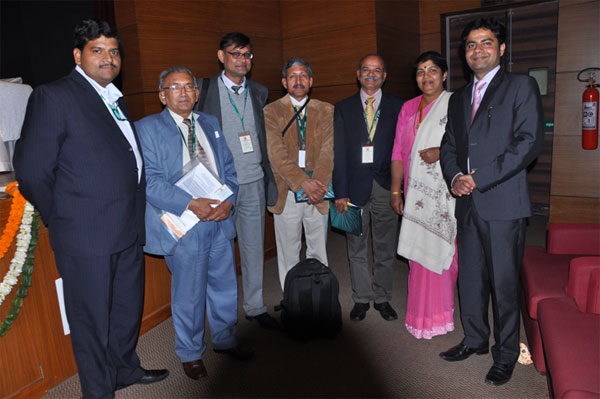
R to L – Mr Kulbhushan Mishra, DR Chanchala Shrivastava, Dr Vasant Shinde,
Dr S N Nautiyal, Dr N S Rajaram, Dr K S Valdiya, Dr Vimal Tiwari
Prof. Vasant Shinde, V.C. of Deccan College Post Graduate and Research Institute, Pune made a very comprehensive presentation on Art and Craft since Vedic times and continuity through the ages.
He elucidated the cultural developments and the advancement of civilization by showing evidence of artefacts found from a large number of sites located at different places along the ancient courses of Indus and Saraswati. The large variety of pictures of excavated artefacts shown by him made it abundantly obvious that there has been cultural continuity from Vedic times to the present through the Harappan period. There has been a similarity in Vedic Fire Altars in these areas for thousands of years, criss-cross pattern of crops, similar types of pottery and ornaments, and burials reveal the faith in life after death. The most interesting part is that Dr Shinde displayed that almost all these things exist to date and remain in use in India. He thus explained that archaeology provides enough evidence to prove that there has been cultural continuity in India for the last thousands of years.

(Similarity of Harappan Pottery with modern-day pottery: Shri Shinde)
Dr C.M. Nautiyal, Scientist in charge of Radiometric Lab, Birbal Sahni Institute of Palaeobotany, Lucknow made a presentation on the ‘Plants mentioned in Vedas, Epics and Puranas: Scientific and Radiometric Data’.
DR Nautiyal talked about the C-14 dating method in short. Thereafter went on to describe that a larger number of crops mentioned in Vedas and Epics have been found as compared to the large trees. He showed the sites in the Ganga plain where early farming tradition continued from 7000 BCE to 2000 BCE followed by the advanced farming phase. He gave examples of Crops like Rice, wheat, Sesame sweet Peas etc in Lahuradeva, Jhusi, Tokwa, Kunal and Banawali dated from 7000 BCE onwards. He gave a very interesting example of Herbal Shampoo in use in Banawali (Haryana), made of Aanwala, Shikakai and dated more than 4700 years BP, which obviously means the Mahabharat era.
Dr N.S. Rajaram, an eminent author, mathematician and linguist, from Boston, USA made a presentation on ‘Mahabharata knows Harappans as Vedic: Inference from the Indus Seas’.
He explained that archaeology and literature had been kept separated through an imagination known as the Aryan invasion theory, of which there is no scientific basis. He showed that there was no discontinuity and Harappan and Vedic civilizations were part of the same continuous development. He further explained that there were references to three famous Harappan seals (namely Unicorn, Humped Bull and Three Animal Headed Mudra) in Mahabharata.
Prof. Krishna Bihari Pandey, the former Vice-Chancellor of C.S.J.M. University, Kanpur and former Chairman of U.P. Public Service Commission, made a very interesting presentation on ‘Science and Technology since Vedic times’
He elucidated the achievements in the field of science and technology in ancient India. He also reminded the participants about the inventions of Sushrut, Charak, Aryabhata and Bhaskar Acharya etc. and emphasized the need for disseminating the scientific knowledge contained in ancient Sanskrit books. Prof. Pandey also explained in detail the scientific inventions of the Vedic period in the fields of Astronomy, Mathematics, Ayurveda, Chemistry, Technology, Aeronautics, Physics etc. reproducing the relevant slokas. Hundreds of discoveries which are attributed to the modern scientists of Europe were actually documented thousands of years back by the scientists/rishis of ancient India.
Valedictory Function on 24th February 2014
In the Valedictory Function on 24th February 2014, Smt. Saroj Bala who is the moving force behind this seminar, presented the summary of the proceedings. During the Valedictory Function, Shri Manbir Singh, Member of UPSC, opined that while religion may be a matter of faith, researching the true heritage is of utmost importance.
Justice Som Nath Aggarwal, who was the Chief Guest, delivered the valedictory address, talked about the antiquity of India's rich cultural heritage and threw light on our legal inheritance, particularly in family laws and principles of governance under Ram Rajya. He further added that cultural heritage of India is much older than what is normally believed and a lot of efforts are yet to be made to unearth the true facts. While appreciating the efforts made by Smt. Saroj Bala and her team members from I-SERVE Delhi Chapter for carrying out multi-disciplinary scientific research, he emphasized that much more remains to be still done and that 'there are miles to go before you sleep'. Justice Aggarwal also released a book titled 'The Origin of Astronomy, Calendar and Time', authored by Kosla Vepa, Director, Indic Studies Foundation, USA and published by I-SERVE.

The Seminar concluded successfully with a vote of thanks by Shri Ashok Bhatnagar.

Dr Gyaneshwar Chaubey of Estonian Biocentre receiving a Memento from Shri Manbir Singh
